Searching for references to enigmatic Rigden Djappo, we have found information on the internet regarding famous artist and mystic Nicholas Roerich. So, who is Rigden Djappo? This mysterious and powerful character is not fully disclosed until today, whereas stories about the Red Horseman are available as legends and myths of ancient peoples. Publicly accessible information is given below.
After the search for the sake of gaining a general understanding, we have run against a strange, but irrefutable fact: there are very few records of Rigden Djappo remaining. Understanding of the available records without a relevant spiritual basis provokes well-grounded doubts, whereas people who are totally unfamiliar with the subject regard such records as fantastic and illusive at all. We have established that the most direct and unmasked references are present in literary works and paintings by Nikolai Konstantinovich (Nicholas) Roerich (09.10.1874 – 13.12.1947), Russian artist, philosopher, writer, traveller, archaeologist, public figure, and founder of international cultural movements such as “Peace through Culture” and “The Banner of Peace”.
Nikolai Konstantinovich not just openly provides information about Rigden Djappo in his works, but also links the Red Horseman’s Personality with records of the advent of the Great Teacher expected in different religions and beliefs. In particular, he mentions the advent of “Messiah with the shining face of the Great Horseman on the Bridge of Worlds”, expected by peoples of Palestine, Syria and Persia; refers to legends of Arabia and Turkestan about Muntazar who will mark the beginning of the New World, to Hindu legends about Kalki Avatar, Buddhist legends about Maitreya, Altai records of the White Burkhan, etc. Multiple names, but single essence: the advent of Messiah and renovation of the world.
Almost everything relating to the Red Horseman is recorded in Roerich’s paintings, among which, in our opinion, the following should be highlighted:
- Command of Rigden Djappo,
- The Great Horseman,
- Shambala Is Coming,
- Kalki Avatar,
- The Miracle. Appearance of Messiah,
- Maitreya the Conqueror,
- The Last Angel... (source of paintings).
We suspect that each of the paintings has its own mystical underlying message or hidden sense. As a matter of fact, the artist often gives his own explanations. Some of them are stated below:

The Great Horseman (Rigden Djappo, the Shambala Sovereign) (1927)
Nicholas Roerich presented this painting to the government of Mongolia. He explained the painting meaning himself, while handing it over to the government chairman: “Mongolian people are building their bright future under the banner of the new age. The Great Horseman of liberation is rushing above Mongolia territory... The Great Khuraldan composes solutions for the people’s new life. And the call of the wonderful Red Horseman is loudly sounding. In the times of Asia flourishing, an artwork or a book were considered the best gifts. The best times of Asia have come again...”
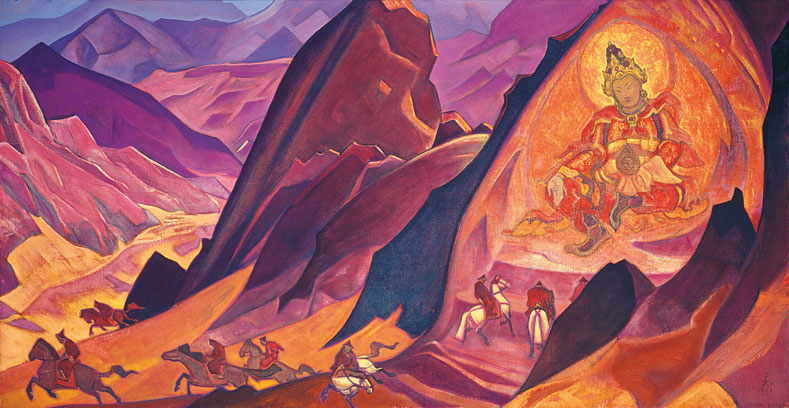
Command of Rigden Djappo (1933)
“Blessed Rigden Djappo comes to issue commands to his messengers. The powerful Sovereign appears on the black rock of Ladakh. Horsemen-messengers approach Him from all parts of the world to receive His commands in sincere respect and them rush across the world, carrying precepts of the highest wisdom ... Rigden Djappo is tireless, eternally awake for the mankind’s sake. His eyes are never closed. In His magic mirror, He sees all earthly events. And the power of His thought penetrates remote lands. There exists no distance for Him. He can render help to those who deserve in a split second.”
![]()
Kalki Avatar (1932) “Messiah, Maitreya, Muntazar, Mitalo, and the entire line of glorious names, diversely expressing one and the same innermost and most cordial aspiration of the mankind. Especially enthusiastic words are said by prophets about the future. Re-read all pages of the Bible, where the brightest human expectation is presented; read Buddha’s commandment about Maitreya. Look how brightly Muslims are telling about the future prophet, how wonderful India’s words are about the end of the dark age of Kali Yuga and the brilliant beginning of the white age of Satya Yuga, how majestic is Kalki Avatar’s image on the white horse! With the same cordiality, remote Oyrots expect the White Burkhan, and our Old Believers search for Byelovodye in Himalayas, making this difficult path for the sake of the future only. For the sake of the same bright future, a lama, with tears in his eyes, is telling about the treasures and power of great Rigden Djappo who will destroy the evil and restore justice. Geser Khan’s victories lead to the future as well. On every New Year eve, the Chinese light candles and pray to the Sovereign of the future. And the white horse is already saddled in Isfagan for the great Advent. If you want to touch the best chords of the mankind, start speaking of the future, of what human thinking is directed at even in the remotest deserts. Particular cordiality fills such aspirations for the World transformation.
In the darkest times, amidst the tightness of thoughtlessness, there sounds an encouraging voice about the Great Advent, the New Era, the time when people will be able to use all their innate abilities reasonably and with inspiration. Everybody interprets the Light Age in their own way, but one thing is the same for everyone: each person interprets this Age in the language of his/her heart...
Kalki Avatar is the Leader, the Great Maitreya, the Sovereign of the future. On the painting we see Him in the clouds on a white horse. He is rushing above the Earth, helping people and saving the planet. Avatar is moving in fiery purple gleams, which is the colour of the power of His Spirit.”
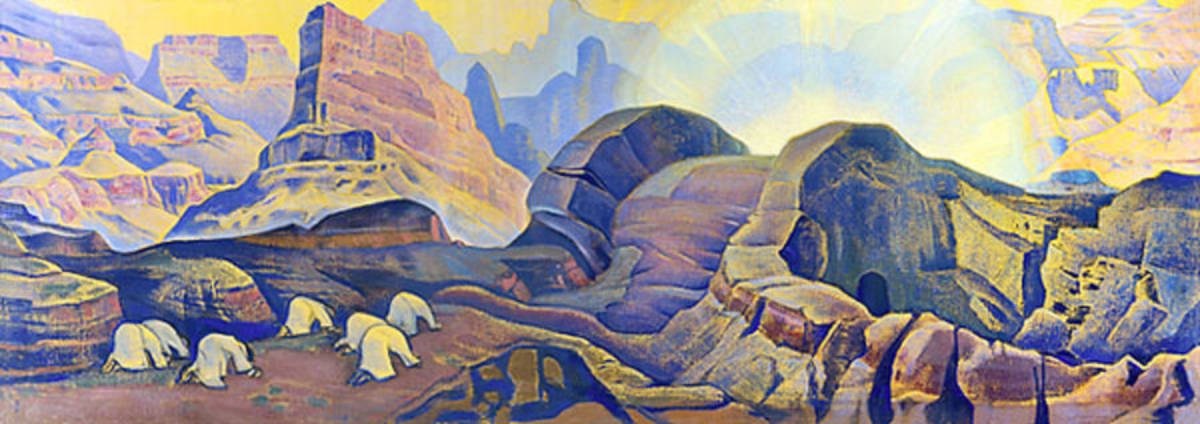
The Miracle. Appearance of Messiah (1923)
“Messiah will come across the bridge... A noble Abyssinian says: “We have an ancient legend. When the Saviour of the World comes, Hi will cross the stone bridge. And the seven know about His advent. Once they see the light, they will fall down to the earth and bow before the Light.” (Nicholas Roerich. The Flaming Stronghold, Riga)
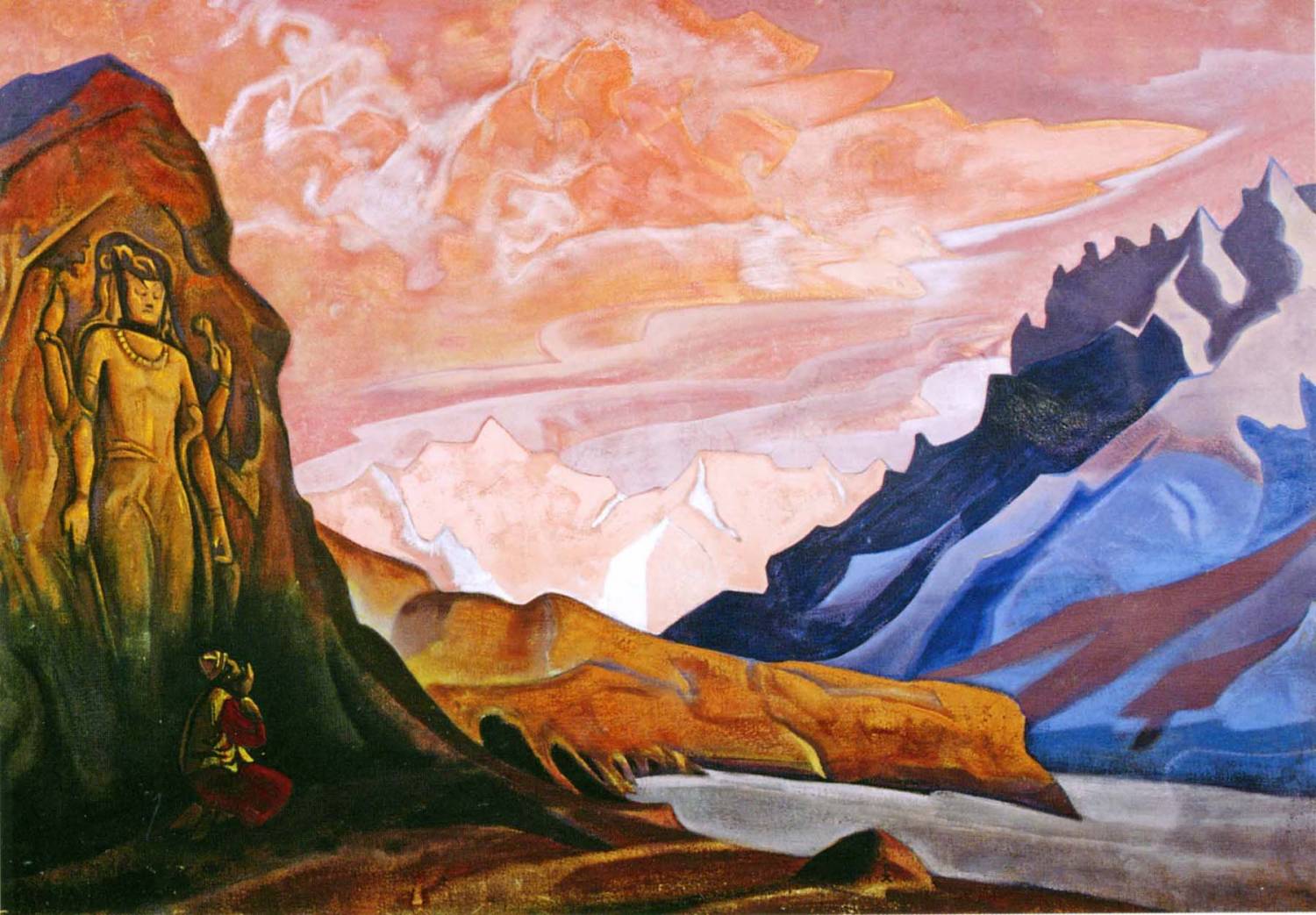
Maitreya the Conqueror (1925) “A strained expectation of the miraculous advent of future Buddha gains a fantastic solution in the last painting of the series: Maitreya the Conqueror. Over the mountain tops, in the fiery sky there rushes Rigden Djappo, the Shambala Blessed Sovereign, on his horse, leading his army to the final battle with the dark forces. This is a real visual embodiment of the New Era legend spread across the boundless Asia territory.” On the painting Maitreya is symbolically depicted as a cloudy horseman, whereas the huge figure of Multi-armed Dukkar graven in the rock is what Roerich’s expedition saw many times on Tibetan paths. Against the background of majestic mountains panorama, there is praying man. He is looking heavenward, where among the clouds there is a distinct silhouette of Sovereign Maitreya and other horsemen, the Sovereign’s warriors hurrying for the fight with dark forces for the establishment of Peace and Culture on the planet Earth.
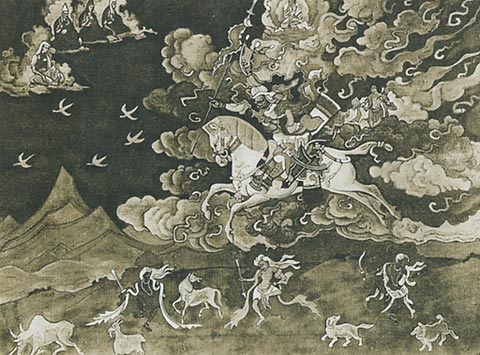
Unfortunately, we cannot post a better image of the painting (no images with higher resolution are available on the internet), since the location of the painting itself is unknown.
Shambala Is Coming (1926 or late 1925) An immediate reason for the painting creation was the ancient thanka (Buddhist icon) called The Red Horseman, which Roerich received as a gift in Ladakh. Therefore, the artist often called the entire series of paintings by this name.
“On a red horse, with a red banner, the red horseman covered with armour is impetuously rushing and blowing the sacred shell. Sparks of scarlet flame are sprinkled from him and red birds are flying in front of him. Snow and Belukha mountain are behind him, and White Tara is sending her blessings. The assembly of great lamas is rejoicing. Under him, there are guards and animal herds as symbols of the place”. This is how Roerich described the image on the aforesaid thanka. The artist used the same plot, with preservation of stylistic peculiarities of Buddhist iconography, in Shambala Is Coming, the first painting of this series (painting location is unknown).
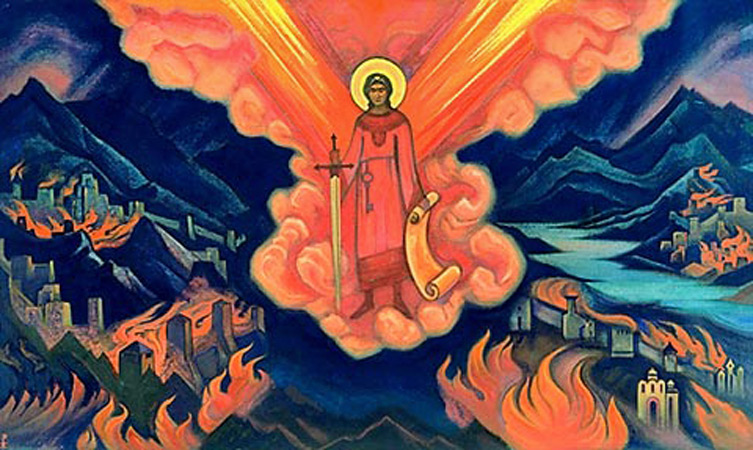
The Last Angel (1942)
The painting was drawn by Elena Roerich’s prophetical dream. Nicholas Roerich created several paintings of the Last Angel. They were drawn either during or prior to the most terrible events that threatened his Motherland, therefore they were often prophetical by the message. The last Angel is adamantly standing amidst curling fiery clouds, above the Earth which is blazing with the last flame. The painting contains a message of retribution for demolition of cities, destruction of cultural monuments, and poisoning of the planet. The flame-coloured Angel holds a scroll in his hand, protecting and defending the genuine Culture, which scroll contains a list of persons who followed the spiritual self-improvement path, who will save themselves and enter the New Era of Light. The Angel also holds a purifying sword and a key to the New World of Beauty and Knowledge. According to the Bible, 7 Angels arrived to the Earth, and now the last one is descending in the form of a chalice. He is as if in the Lord’s fiery palms. He has burning wings, Oriental face, and Russian clothes. His belt is a symbol of the highest power.
This painting might not have immediate relation to Rigden Djappo, but its hidden sense of obvious: renovation of the world.
There are also records of Rigden Djappo in Roerich’s work Shambala Beaming. Here’s one of those: «Even Rigden Djappo himself sometimes comes in a human body. He unexpectedly shows himself in holy places, monasteries, etc., and communicates his Prophecies at time due.
The Governor of the World attends the Temple at night or early in the morning, before the sunrise. He enters. All lights go on simultaneously by themselves. Some of the present recognize the Great Wanderer right away. Lamas gather respectfully and listen to his prophecies of the future with deepest attention.
The Great Epoch is approaching. The Governor of the World is prepared for the Battle. Many signs appear. The Cosmic Fire is approaching the Earth again. Planets foreshadow the New Era. However, numerous disasters will take place before the New Era of prosperity sets in. The mankind will be tested over again, so as to verify whether their spirit has sufficiently evolved. Underground fire endeavours to unite with the Fire element of Akasha. If all good forces fail to join their powers, great disasters will be inevitable.
They say blessed Rigden Djappo comes in order to issue commands to his messengers, just like the powerful ruler appears on the black rock on the way to Ladakh. Horsemen arrive from everywhere to listen to Him respectfully and rush back to execute his commands of the great wisdom.”
Having somewhat extended the knowledge of Rigden Djappo’s names mentioned by Nicholas Roerich in his works, it is certainly worth noting there is much in common in records and legends preserved by different people of the world.
For instance, Kalki Avatar, or the White Horse Avatar is to be the last Avatar, the tenth incarnation of god Vishnu, according to Brahmans; Maitreya is to be the last incarnation of Buddha, according to northern Buddhists; Sosiosha will be the last hero and Saviour, according to Zoroastrian legends. As some sources indicate, when Vishnu (Kalki Avatar) comes for the last time, heavens will open wide, and he will appear as the Saviour, riding a white horse with his sword raised, and the horse will be the evil spirit’s shell, on which Vishnu will be riding until overpowering the evil spirit for the last time. With his sword Avatar exterminates enemies and destroys the unfair world, thus restoring dharma and preparing the future revival of the world.
Who is Muntazar? He is Messiah glorified and expected in all countries of the Muslim world: Imam Mahdi, the Hidden Imam. According to the information available on the internet, Al Mahdi (Muntazar) is an actually existing person who is already present on the Earth, who lives among people and sees everything that takes place here, although he himself is not seen to anyone. “He evidences how sufferings of the oppressed, despair of the hopeless, evil of the oppressors are accumulated on the Earth. He observes all this close and from afar and waits for the hour to be able to offer his hand to every oppressed, every miserable, every hopeless, and to exterminate all oppressors without exception. This expected leader is destined neither to announce himself, nor to show himself to people, although he lives among them, waiting for the promised hour”. His advent will be a sign of the last hour approach.
There is another interesting record of the Saviour or Messiah among Altai peoples, and it is mentioned in Roerich’s works. It’s an ancient legend about the White Burkhan, which relates to legends of Central Asia. In particular, we came across one of such legends described by Nicholas Roerich in his book The Heart of Asia: “In 1904, a young Oyrot girl had visions. Blessed Oyrot appeared in front of her on a white horse and told her he was a messenger of the White Burkhan, whereas the White Burkhan himself was to arrive soon. The Blessed gave the shepherdess a number of instructions on how to restore pious customs in the country and to meet the White Burkhan who will construct the new happy time on earth… There still exists a legend whispered in scattered jurtas that the last human battle will take place on Katun River, and that the White Burkhan’s light is already shining from the remote White Mountain.”
The idea that Rigden Djappo, the Sovereign of Shambala (the spiritual centre of the Earth) is the Messiah runs through all preserved records and sources; he is exactly the Avatar who comes to the Earth at the times of the world renovation, evaluates and decides the world’s fate.
POSTSCRIPT.
Let’s go back to our time. Impartially evaluating the situation, we can say that the most information about Rigden Djappo, besides Nicholas Roerich’s works, is contained in the books by contemporary writer and artist Anastasia Novykh who prefers to stay incognito and never appears publicly. We mean, first and foremost, the series of her books named Sensei of Shambala, where the concept of Shambala itself and the image of Rigden Djappo are disclosed. At that, the most important and fundamental of the author’s works is AllatRa book published in 2013. According the Anastasia Novykh’s official website, the author finished writing this book at 9.00 on 21.12.2012 (source). This is quite a symbolic coincidence, for exactly this date was predicted as the date of the End of the Word, actively promoted and discussed at that time. Does the AllatRa book represent another chance for the mankind to gain the brighter future? Well, let’s not fantasize. After all, our major goal is facts and precise analysis. The book itself is written in the “question – answer” style (source), and although it is indicated as fiction, the information contained therein, in our opinion, is worth a more serious review and even study, since it touches various fields of science, e.g. physics, chemistry, astronomy, astrology, astrophysics, as well as human energy structure and religion. Moreover, if the book is examined more thoroughly, it becomes apparent that the knowledge given in it forestalls the knowledge currently possessed by the mankind. And the most important thing is that the knowledge in the book is given on behalf of Rigden Djappo, the Red Horseman, Shambala Sovereign. This fact makes one ponder over where the author of fiction books has taken such information from...
We will surely investigate the issue in more detail. Follow our further publications.
Prepared by Eva Kim.
 Who is Rigden Djappo? References in Nicholas Roerich's works.
votes:
467
Who is Rigden Djappo? References in Nicholas Roerich's works.
votes:
467
|

Project Aim










Leave comment